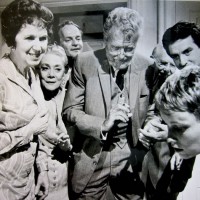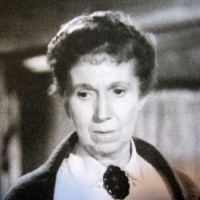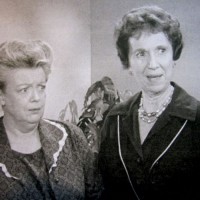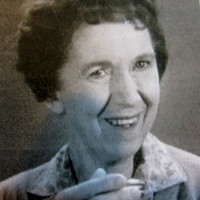Hope Summers: Rifles, Pickles & Rosemary's Baby
The Fascinating Career of a Bradley Speech Teacher
She arrived in Peoria in 1926 to become the new head of the Bradley Polytechnic Speech Department. Few could guess her career would lead her to be one of America's most sought-after character actors, appearing in hundreds of early television shows and more than 32 movies.
Hope Summers was born in Mattoon, Ill., in 1896. Her father, Dr. John Summers, was the town physician. He would later relocate to Walla Walla, Wash., where he would be elected to the United States Congress from 1919 to 1933.
Hope attended Northwestern University and graduated in 1923 from the School of Speech. Bradley Polytechnic hired the fresh-faced young girl in 1926 to head their speech department, which was part of the Bradley Conservatory of Music.
Living on her own for the first time at 808 Bradley Avenue, Hope enjoyed her teaching duties, both on campus and giving private acting lessons off campus. She directed the 1926 Bradley play "The Romantic Age." But the acting bug soon pulled Hope in.
Hope Summers volunteered for Peoria Players, which at the time held performances at the Peoria's Women's Club second story theater. She directed two plays for the 1925-26 season: "Mansions" by Hildegarde Flanner and "Colombine" by Colin Clements.
But then she was cast in the lead role in the Peoria Players, March 1926 production "R.U.R." by Karol Capek. The local reviews were sensational. The Peoria Transcript wrote, "I don't happen to think of any actress at the current moment who could have surpassed Miss Hope Summers' work. Her picture of the young Helena — eager, curious, ardent and swayed visibly by many criss-cross eddies of emotion — was unforgettably charming. There were warmth and tenderness and an irresistible appeal in the portrait in the quivering curves of the young mouth, the sorrow and sympathy in the eyes and the throb of pity in the round white throat."
In June 1927, she left Bradley to marry Peoria businessman Claude James Witherell and moved to Winnetka, Ill. There Hope started her professional acting career, which would keep her constantly employed until the day she died.
Hope Summers began to become known for her regional theater work. Her one-woman show, "Backstage on Broadway," was successful enough to enable her to crack the competitive Chicago radio market with scores of radio dramas. In 1951 she was cast as Belinda Catherwood in the world's first successful television soap opera, "Hawkins Falls," which was filmed live in Chicago.
Hope's plain matronly nurturing physical attributes enabled her to assume many character roles for hundreds of early television shows of the 1950s and 1960s. You can catch her performances on reruns of such beloved series as "Wagon Train," "Maverick," "Loretta Young Show," "Alfred Hitchcock Presents," "Peter Gunn," "Dennis the Menace," "Dr. Kildare," The Untouchables," "Gunsmoke," "Hazel," "My Three Sons," "The Dick Van Dyke Show," "Petticoat Junction," "The Beverly Hillbillies," "Gomer Pyle," "Bewitched," Hawaii Five-0," "MASH," and "Little House on the Prairie" to name just a small number.
Two television series were standouts for Hope's career and made her internationally famous. The first was the western "The Rifleman" (1958-1963) starring Chuck Connors. Hope played Hattie Denton, the mother figure for the motherless McCains, always ready to serve her chicken soup and greens, mend wounds, and babysit at a moment's notice.
But it was her role on the "Andy Griffith Show" (1960-1968) as Aunt Bee's neighbor Clara Edwards that people will forever identify her. Ken Beck summarized Clara and Aunt Bee's relationship, writing "though they can be keen rivals (notably in cooking, gardening and courtship), Clara and Aunt Bee are the best of friends. They've known each other since their basketball days at Sweetbriar Normal School. Clara's pickles are without competition — especially from Aunt Bee. However, Aunt Bee can make a run for Clara's roses. And sooner or later, every potential beau knows that both ladies have a sporting chance at his affections."
Many "Andy Griffith Show" fan clubs name the episode that aired on Dec. 18, 1961, "The Pickle Story," as the funniest show of the entire series. The show centered around Clara and her blue-ribbon winning pickles, where every jar was a loving tribute to her dead husband. Aunt Bee's pickles were known to taste like kerosene, and what Andy, Barney and Opie do to remedy that is television history.
Hope Summers acted in more than 32 motion pictures, some of the more known ones being Zero Hour!, I Want To Live!, Inherit the Wind, The Children's Hour, Spencer's Mountain, The Ghost and Mr. Chicken, The Shakiest Gun in the West and The Learning Tree.
In 1968, Roman Polanski cast Hope as the sinister witch Mrs. Gilmore in his horror film Rosemary's Baby. Audiences were jolted from the loving image of Mayberry's Clara to the skin-crawling discomfort of Hope's devil matron.
Hope's last movie was Foul Play in 1978 with Chevy Chase and Goldie Hawn.
She died of heart failure in Los Angeles on June 22, 1979. Her legacy of portraying hundreds of characters leaves one more to be told, one in which you only heard Hope Summer's voice: From its start in 1961 until her death in 1979, Hope was the kind nurturing inviting voice of Mrs. Butterworth's Maple Syrup.




